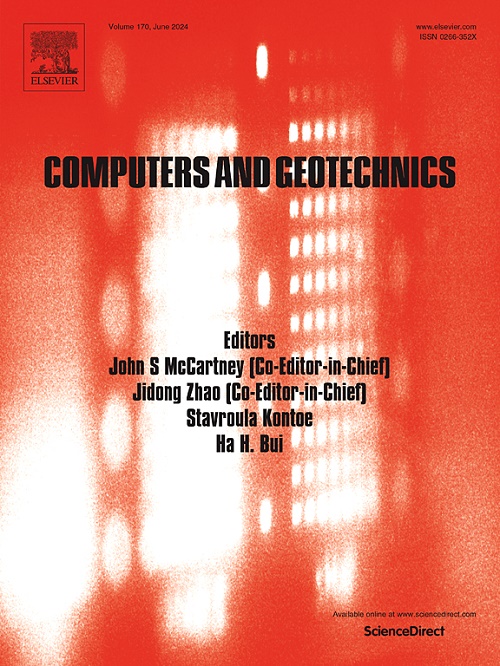An implicit nodal integration-based three-dimensional particle finite element model for simulating dynamic saturated porous media
IF 6.2
1区 工程技术
Q1 COMPUTER SCIENCE, INTERDISCIPLINARY APPLICATIONS
引用次数: 0
Abstract
Large deformation analysis of dynamic saturated porous media holds significant importance in accurately describing the life of various geotechnical and geological applications, since they can seamlessly capture the continuous variation of geomaterials with extreme changes in configurations and properties. Many numerical models have been developed, while most of them are limited to two-dimensional scenarios and explicit time integration schemes, which therefore compromise their accuracy and efficiency in studying low- and medium-frequency practical problems. In addition, different stabilisation techniques with tunable parameters are often required when using the efficient linear elements for dynamic analysis. To overcome these hurdles, this work introduces an implicit three-dimensional nodal integration-based particle finite element method (N-PFEM) that combines the advantages of a mixed variational principle, a nodal-based strain smoothing technique, mathematical programming, and the particle finite element method, ensuring the accuracy and robustness in analysing dynamic saturated media. The three-dimensional N-PFEM is thoroughly examined against four numerical benchmarks, for which numerical solutions agree well with reference solutions or experimental data. The model is further applied to simulate earthquake-induced slope failures, which characterises the effect of material property on the initiation and propagation of landslides in a three-dimensional space. The developed model holds important implications for developing numerical approaches and demonstrates strong potential as an effective and practical tool in analysing the hydro-mechanical behaviour of geomaterials in real applications.
基于隐式节点积分的动态饱和多孔介质三维颗粒有限元模型
动态饱和多孔介质的大变形分析对于准确描述各种岩土工程和地质应用的寿命具有重要意义,因为它们可以无缝地捕捉地质材料在结构和性质上的极端变化的连续变化。目前已经开发了许多数值模型,但大多数仅限于二维场景和显式时间积分方案,因此影响了它们在研究低中频实际问题时的准确性和效率。此外,当使用有效的线性元素进行动态分析时,通常需要不同的具有可调参数的稳定技术。为了克服这些障碍,本工作引入了一种基于隐式三维节点积分的颗粒有限元方法(N-PFEM),该方法结合了混合变分原理、基于节点的应变平滑技术、数学规划和颗粒有限元方法的优点,确保了动态饱和介质分析的准确性和鲁棒性。通过四个数值基准对三维N-PFEM进行了全面检验,数值解与参考解或实验数据吻合较好。该模型进一步应用于地震诱发的边坡破坏模拟,在三维空间中表征了材料性质对滑坡发生和传播的影响。所开发的模型对数值方法的发展具有重要意义,并显示出作为分析实际应用中岩土材料的水力学行为的有效和实用工具的强大潜力。
本文章由计算机程序翻译,如有差异,请以英文原文为准。
求助全文
约1分钟内获得全文
求助全文
来源期刊

Computers and Geotechnics
地学-地球科学综合
CiteScore
9.10
自引率
15.10%
发文量
438
审稿时长
45 days
期刊介绍:
The use of computers is firmly established in geotechnical engineering and continues to grow rapidly in both engineering practice and academe. The development of advanced numerical techniques and constitutive modeling, in conjunction with rapid developments in computer hardware, enables problems to be tackled that were unthinkable even a few years ago. Computers and Geotechnics provides an up-to-date reference for engineers and researchers engaged in computer aided analysis and research in geotechnical engineering. The journal is intended for an expeditious dissemination of advanced computer applications across a broad range of geotechnical topics. Contributions on advances in numerical algorithms, computer implementation of new constitutive models and probabilistic methods are especially encouraged.
 求助内容:
求助内容: 应助结果提醒方式:
应助结果提醒方式:


